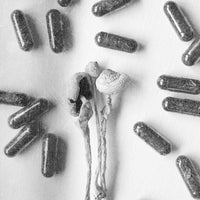“Who’s taking notes?” is usually the first question people hear at the beginning of team meetings. That question is usually followed by a series of groans before someone reluctantly volunteers for the job. Here at MUD\WTR, we do team meetings a little differently. The first question the team hears at the beginning of our all-hands meetings is, “Chris, you ready?”
That’s the cue for Chris Keener, the head of MUD\WTR :films and a professional breathwork coach, to lead the 30-plus-person team in breathwork. Research suggests that these short breathing exercises are effective tools for managing stress, promoting openness and curiosity, and increasing creativity—all things pretty much everyone looks for during their workday. It’s an especially powerful tradition for a fully remote team.
“Doing breathwork in meetings is like opening a window to let a fresh breeze into a stuffy room,” says Keener. “It's a beautiful way to just kick off the meeting and then we go into serious business from there.”
For MUD\WTR’s Founder and CEO, Shane Heath, those few minutes can make the difference between a mediocre meeting and a great one. “Meetings can be either a waste of time or an asset, depending on how you approach them,” Heath says. “Taking time to breathe at the top of a meeting might sound like a waste of time, but think of it like taking aim before you fire. A few mindful minutes at the start of a meeting can ensure you’re hitting the bullseye every time.”
Breathwork Techniques for Team Meetings
MUD\WTR's healthy team habits are easy to replicate at any business. No gatekeeping here! Our purpose is to create healthy minds through healthy habits, so the more people who join us, the better. Here are Keener's top three breathing exercises for company meetings.
The 7/11 Breathing Exercise
This exercise has been used for thousands of years—and for good reason. It is one of the most powerful breathing techniques to help reset your day and quickly boost your mood. Plus, it’s as simple as its name. Here’s how it works:
Breathe in for a count of seven. Then breathe out for a count of 11.
While you’re breathing, try to focus your breath deep into your stomach. This is called diaphragmatic breathing and it’s better for relaxation than shallower breaths focused in your lungs. It may even help to place your hands on your stomach while you breathe so that you can feel your belly swell and relax as you breathe in and out.
If breathing in for seven and out for 11 is too difficult, you can shorten the count to breathing in for three and out for five. Choose whichever breathing count works best for you. An added bonus to 7/11 breathing is that the counting can actually work as a distraction and help take your mind off of your work-related to-do list.
Super Sighs
The super sigh breathing method is a scientifically proven way to calm the team’s nerves and drop into the present. For super sighs breathwork, start by breathing through the nose until the lungs are halfway full. Pause there, then fill the lungs completely with another breath. Once your lungs are full, slowly exhale out of the mouth.
The Flow Breath Method
The flow breath technique is a simple sequence to invite that productive “flow state” and get your team in sync. The flow breath practice consists of a double inhale and a single exhale for a period of time. Continuing this practice for at least five minutes is the most effective way to access the flow.
What are the Benefits of Doing Breathwork at Work?
From the early days at MUD\WTR, Heath knew he wanted to incorporate breathwork into meetings to act as a “buffer” between employee workflows and team collaboration.
He wanted a practice that could “create focus and presence and safety in the meeting so that when we're there, we're creative, we're courageous, and we can maximize the time spent together.”
Breathwork is a non-negotiable ingredient for MUD\WTR’s culture and it’s been transformative for team meetings. Not only can these practices reset employees’ minds so that they’re able to collaborate more effectively during meetings, but breathwork can also foster a sense of connection among the team.
How Do You Start Breathwork?
Interested in trying breathwork at your place of work but unsure of how to start? Try following these three tips from Keener to help ease into the practice.
1. Consider the tone and content of the meeting. Is it going to be a really dense deep dive into finances? A few minutes of slow, conscious nasal breathing will give everyone a sense of feeling refreshed and clear-headed. Is it a creative brainstorming session? Big, activating breaths accompanied by some simple body movements are great for increasing creativity.
2. Keep it simple. Sometimes the simplest techniques yield the greatest results. An example is what’s known as a “resonant breath” (6-second inhale and a 6-second exhale), which is known to promote heart health, reduce stress, synchronize brain activity and even improve sleep.
3. Don’t take yourselves too seriously. One of my favorite things to do at the start of our all-hands meeting is to ask everyone to stand up and start shaking. The super sigh is also a fun one. Being playful can make these things more inviting to all participants, especially those who might not be as familiar with a breathwork practice.




